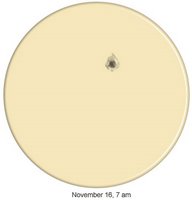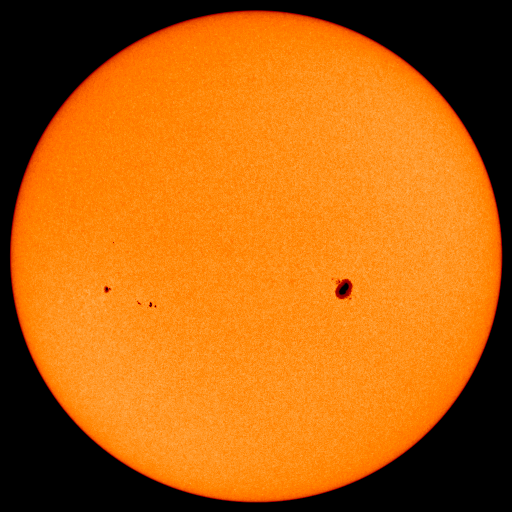Thursday, December 21, 2006
Merry Christmas!! and Happy New Year!!
I'd like to thank Colin Henshaw for his another article related to astrophysics.
The nights are longer these days (with winter solstice a few hours away from now, while I am typing this). Longer nights mean longer time for observation but the cold is at its peak and we have foggy mornings here. Last night, when I woke up to go to the bathroom, I saw a meteor streak past the sky. In fact, I have seen many meteors in the last few days. I think they belong to the Ursids.
About the Geminids, I didn't actually go out to see it because I was very busy with one of my cousin sisters' marriage ceremony and many other wedding parties. In one of the parties, at about 6 in the evening, many of us saw a big fiery dot passing slowy above us. I told people it could be the ISS but I am still not sure because I have not checked any software. What I know for sure is that it was really bright!!! lol ;-) There were just a few stars seen at that time with all the lights in the party.
I hope everybody will have a great time this christmas, and new year...
Merry Christmas!! and Happy New Year!!
Monday, December 04, 2006
ISSUE II
Text preview from skygazing section:
Like last month the Moon will again occult the Pleiades star cluster (M45). This month this occurs at about 9:30 am Nepali Standard Time on 4th of the month. This means it will not be seen from Nepal. It will be observed from different parts of North America and Europe though it will not be observed from Southern parts of the world.
Mercury rises at 5h08m NST, Mars at 5h41m NST, Jupiter at 6h04m, and Sun at 6h37 on December 1st. Mercury will slowly enter the glare of the sun while Mars will rise earlier making it visible for the rest of the month. Jupiter will rise more than two hours earlier than the sun by the end of December and increase its brightness to magnitude -1.8.
Mercury, Jupiter and Mars will make a very small triangle in the morning of 10th December. Mercury will pass very close to Jupiter (less than one degree) which will be visible from some parts of the pacific (around 20 deg North +165 deg West near Honolulu) right before sunrise. These three planets will make another triangle in the morning of 11th December reaching east of Jupiter.
Venus is the evening star with a very bright magnitude of -3.9 for the month.
Saturn will be two hours earlier by the end of the month from its rise time at 22:42 on the first to 20:42 on the last. It shines at magnitude 0.7 till the end of the month while it nears earth.
Sunday, November 19, 2006
Discovering with SOHO: STEREO
This same school has a great website and has recently added a section about Solar Terrestrial Relations Observatory (STEREO) spacecraft. Visit http://astronomy.neatherd.org/SOS/SOHO/SOHOstereo.htm
This text from NASA's official site for STEREO:
STEREO (Solar TErrestrial RElations Observatory) is the third mission in NASA's
Solar Terrestrial Probes program (STP). This two-year mission will employ two nearly identical
space-based observatories - one ahead of Earth in its orbit, the other trailing
behind - to provide the first-ever stereoscopic measurements to study the Sun
and the nature of its coronal mass ejections, or CMEs.
STEREO's scientific
objectives are to:
Understand the causes and mechanisms of coronal mass
ejection (CME) initiation.
Characterize the propagation of CMEs through the
heliosphere.
Discover the mechanisms and sites of energetic particle
acceleration in the low corona and the interplanetary medium.
Improve the
determination of the structure of the ambient solar wind.
We hope to put an article on this in coming issues of The Astral Journal pdf ezine.
Friday, November 17, 2006
New Sunspots


In the morning hour, when the sky is mostly covered with fog, or at sunset we can actually see the sunspot 923 with naked eyes. The first picture is my photoshop art where I have depicted the 923 exactly where I had seen with naked eyes, the viewfinder of my telescope and the telescope itself. I watched it for just a few seconds. If I had watched for a longer time I'd have damaged my eyes. WARNING: Don't ever try watching the sun with/without any instrument without using a proper solar filter.
2nd picture from spaceweather.com
Do these newly appeared sunspots pose any threat for strong solar flares? (My answer is no.)
Thursday, November 16, 2006
Astronomy vs. Astrology
Lagna is taken from start of the day. The lagna at sunrise is the constellation where the sun is supposed to be that time. Two hours later the constellation rising next to the first lagna of the day is taken as the next lagna. The lagna changes every two hours just like this. But if we are taking the reference point at sunrise and the constellation the sun resides in at the sunrise, then we are purely not using the right constellation. It is because no astrologers are updated with the precession of equinoxes. The calculation is again off by one constellation. So lagnas calculated for any time of the day is wrong. So how can the astrologers be so sure that when they are calculating lagnas they are making more accurate predictions?
Saturday, November 11, 2006
Leonid Meteor Shower 2006

A meteor streaks past the Milky Way in this picture from November 26, 1998 picture of the Day by Jeff Medkeff . While the stars are hundreds to millions of light years away the meteor is just a space rock burning a few kilometers above the earth's surface in the atmosphere.
November is the best time of the year for watching Meteors. Leonid Meteor shower peaks on 19th this month. Evening watchers: Its not the right time to watch but earthgrazers are good to look at. Morning watchers: Its in the mornings that most of the space rocks come into the way of Earth's orbit to enter the atmosphere fast and more in number.
Some researchers state this year's Leonid shower won't be so good. Low meteor rate has been suggested. Keep watching untill 21st from 14th.
Thursday, November 09, 2006
Mercury Transit 2006
You can see visibility map of the transit at http://www.nao.rl.ac.uk/nao/transit/M_2006/. Picture galleries of the transit can be found at the following sites:
SOHO website (NASA) Transit pictures and MPEG videos as seen from SOHO http://sohowww.nascom.nasa.gov/hotshots/2006_11_06/
SpaceWeather (NASA) http://spaceweather.com/eclipses/gallery_08nov06.htm
Animated Transit http://science.nasa.gov/headlines/y2006/20oct_transitofmercury.htm
Tuesday, November 07, 2006
Web-resources: LCROSS, Calendar & Pluto
Because the support site for The Astral Journal is not complete yet, I am posting the web-resource materials for some articles in this blog:
LCROSS: WATER ON THE MOON
LAUNCH DATE: OCTOBER 2008
MISSION: To search for water ice deposits on the Moon
The Astral Journal Oct-Nov 06 Page 4
AMES RESEARCH CENTER WEBSITE:
http://www.nasa.gov/centers/ames/home/index.html
LUNAR PROSPECTOR 1988 MOON MISSION: http://discovery.nasa.gov/prospector.html
LCROSS MISSION PICTURES: http://www.nasa.gov/centers/ames/multimedia/images/2006/lunarorbiter.html
CLEMENTINE MISSION: http://science.nasa.gov/headlines/y2005/14apr_moonwater.htm
From JPL's Space Calendar compiled and maintained by Ron Baalke
Click on the links for more info on the events listed
2006
Nov 08 - Mercury Transits the Sun
Nov 17 - Leonids Meteor Shower Peak
Dec 13 - Geminids Meteor Shower Peak
Dec 22 - Winter Solstice, 00:22 UT
Dec 22 - Ursids Meteor Shower Peak
Meteor Showers List:
http://csep10.phys.utk.edu/astr161/lect/meteors/shower_list.html
PLUTO RESEARCH
Go to Mike Brown's website http://www.gps.caltech.edu/~mbrown/planetlila. He discovered the largest dwarf planet (Eris, also called Xena or 2003UB313).
Wikipedia article on new definition of the word 'planet': http://en.wikipedia.org/wiki/2006_definition_of_planet
More simplified article on new definition of 'planets' and Pluto's planetary status will appear in the 2nd issue of The Astral Journal.
Saturday, November 04, 2006
1st issue
The support (and download) website of The Astral Journal is yet to be uploaded.
The Observation of Variable Stars
Types of Variable Stars
Why observe Variable Stars?
How to observe Variable Stars?
Written by Colin Henshaw
Do you still read your HOROSCOPE?
Why are the signs wrong?
Why do planets affect them?
Astronomy came first...
Written by Pradipta Shrestha
Sky Gazing
November 06 article by Kedar P Badu
MessierWatch
MoonMadness
TwilightPlanets
StarGazing
- 'Da Cosmic Calendar
- LCROSS: Water On The Moon
- The Red Planet in History
- Important Dates
- Astro-Poetry
- Humor: Cosmic Trip Comics Strip
- Space Contest
- Astrophotography
- and more...
The freezine is published through:
